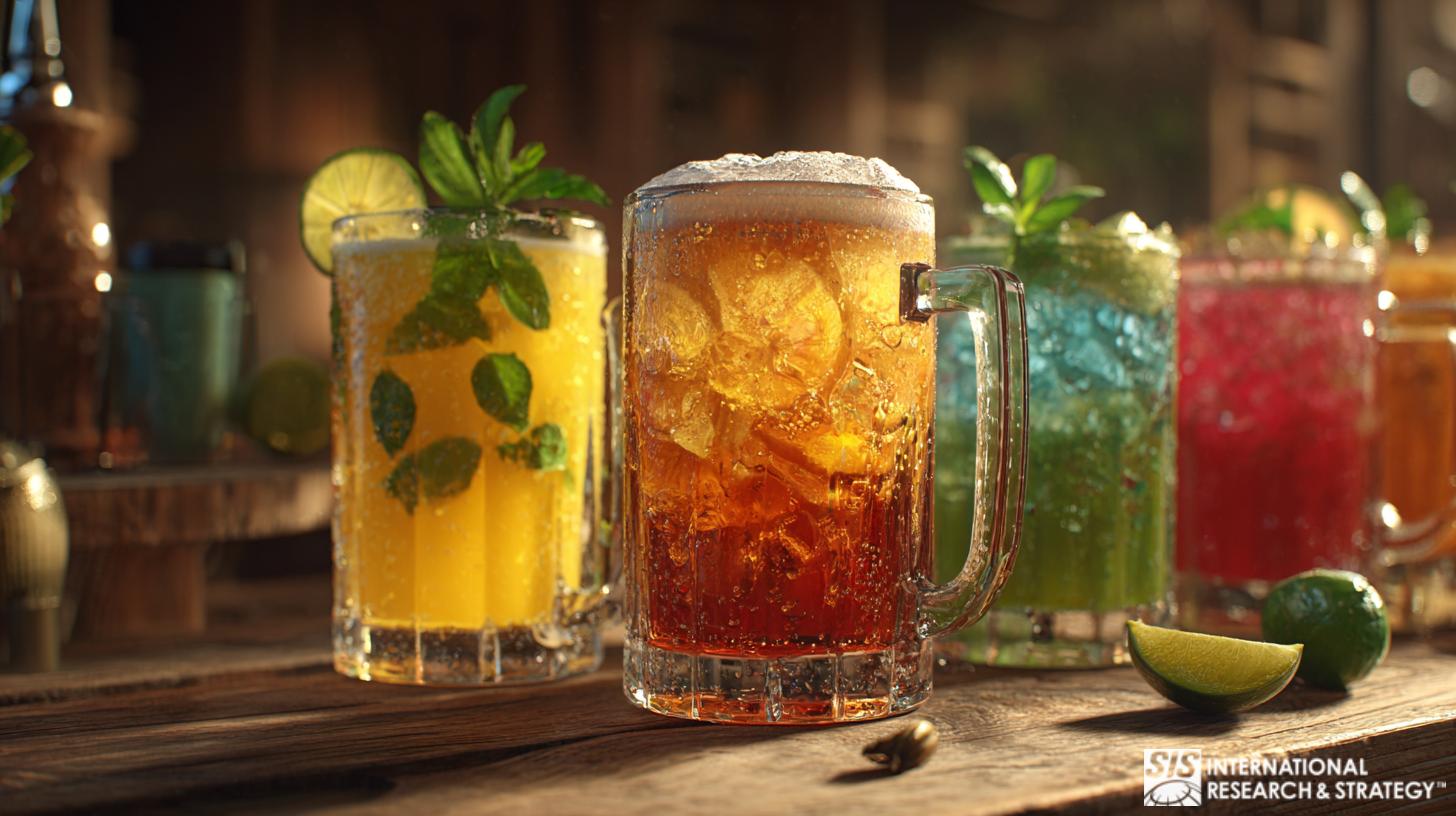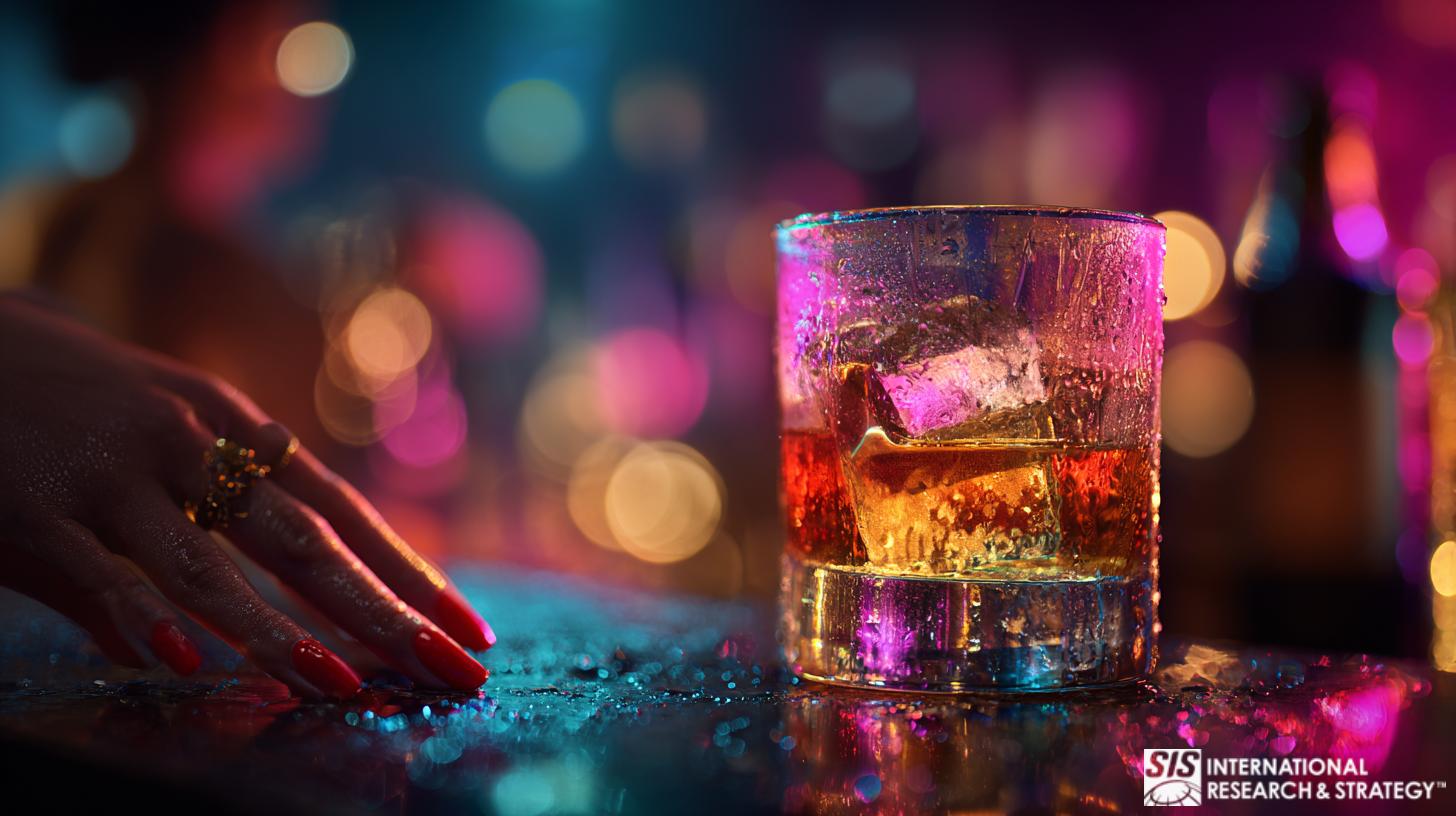アルコールの味覚テスト

アルコールの味覚テストは、飲料業界で重要な役割を果たします。味覚テストは、風味プロファイルの一貫性を確保し、欠陥や異臭を特定し、消費者の好みに合った新製品の開発に役立ちます。
ブランドはどのようにして自社のアルコール飲料を際立たせ、愛好家やたまに飲む人の高い期待に常に応えられるよう保証しているのでしょうか? 完璧なアルコール飲料を作り出す技術と科学は芸術です。そして、アルコールの味覚テストは市場での成功の土台を築き、一口ごとに消費者に発見と喜びの旅を提供することを保証します。
Table of Contents
アルコール味覚テストとは何ですか?
Alcohol taste testing is an in-depth analysis of the complex flavor profiles, aromas, and textures that define alcoholic beverages. It assesses the quality, character, and appeal of drinks, ranging from wines and spirits to beers and cocktails.
This taste testing evaluates the sensory characteristics of alcoholic beverages, including wine, beer, and spirits. It involves assessing appearance, aroma, taste, and mouthfeel to determine the beverage’s quality and characteristics.
During alcohol taste testing, trained professionals, known as “sensory panelists,” use their senses to identify and describe various beverage attributes, such as fruitiness, acidity, sweetness, and bitterness. These evaluations help producers understand consumer perceptions of their products and make informed decisions about product development and quality control.
企業がアルコールの味覚テストを必要とする理由

Alcohol taste testing is essential for ensuring product quality and consistency. It allows producers to identify variations and make the necessary adjustments to ensure that every product reaching consumers maintains the brand’s quality standards. This consistency is critical to building and maintaining consumer trust and loyalty, as customers expect the same experience with every purchase.
さらに、アルコールの味覚テストは、生産者が新しいフレーバー、ブレンド、醸造または蒸留技術を試して、市場の関心を引く革新的な製品を生み出すことができるため、イノベーションと差別化を促進します。この探索と改良のプロセスは、市場のトレンドに従うのではなく、リードすることを目指すブランドにとって非常に重要です。
さらに、アルコールの味覚テストは消費者の好みに関する貴重な洞察を提供し、ブランドはターゲット層の変化する嗜好に合わせて製品をカスタマイズすることができます。しかし、それは企業にとって、次のような他の多くのメリットをもたらします。
- バッチ間の一貫性: アルコールの味覚テストにより、ブランドは変動を綿密に監視し、方法論を調整して、消費者に一貫した製品体験を提供できるようになります。
- 市場の差別化: アルコールの味覚テストを通じて、ブランドは革新的なフレーバーの組み合わせ、製造技術、自社製品を差別化する独自の成分プロファイルを模索することができます。
- 消費者の嗜好との整合: アルコールの味覚テストにより、ターゲット市場の味覚や嗜好に関する洞察が得られ、ブランドはこれらの期待に応えるように製品をカスタマイズできるようになります。
- 強化されたブランドナラティブ: アルコールの味覚テストを通じて明らかになったニュアンスや品質は、ブランドの物語を豊かにし、その伝統、職人技、品質へのこだわりについて、より説得力のあるストーリーを伝えることを可能にします。
アルコール味覚検査を利用する人
の 蒸留酒、ビール、その他のアルコール飲料を製造する職人 アルコールの味覚テストの主なユーザーです。これらの専門家にとって、このプロセスは製品の品質と一貫性を確保するために非常に重要です。 蒸留酒製造業者と醸造業者 また、味覚テストを使用してレシピを改良し、発酵と蒸留のプロセスを調整し、各バッチが厳格な風味、香り、口当たりの基準を満たしていることを確認します。
ソムリエとミクソロジスト rely on alcohol taste testing to deepen their understanding of different beverages and how they can be combined or presented to enhance the drinking experience. These professionals use their refined palates to curate selections for restaurants, bars, and events, ensuring each offering is high-quality and suits the intended audience or theme.
大手飲料会社では、 品質管理アナリスト conduct alcohol taste testing during production to ensure every product meets the brand’s quality standards. These analysts look for any deviations in taste, aroma, or appearance that could indicate issues with the production process, helping to prevent subpar products from reaching the market.
Global Alcohol Industry Market Data & Consumer Taste Insights
| 市場セグメント | Current Value / Data | Projected Growth | Key Consumer Insights |
|---|---|---|---|
| GLOBAL MARKET SIZE & GROWTH | |||
| Total Alcoholic Beverages Market | $2,413.8B (2024) | $3,866.1B by 2032 CAGR: 6.04% |
Driven by premiumization trends and rising disposable incomes globally, particularly in emerging economies where middle-class growth accelerates demand. |
| Craft Spirits Market | $21.32B (2024) | $52.85B by 2033 CAGR: 10.61% |
Exceptional growth fueled by consumer demand for authenticity, artisanal production, and unique flavor profiles. Millennials and Gen Z driving innovation. |
| Distilled Spirits Segment | $82.01B (2024) | $226.82B by 2032 CAGR: 13.56% |
Fastest-growing segment with vodka dominating US consumption (77M 9-liter bottles annually), followed by rum, whiskey, and tequila. |
| REGIONAL MARKET LEADERSHIP | |||
| North America Market | $895.8B (38.4% share) | Leader in craft spirits US CAGR: 29.4% |
US consumers show strong preference for premium spirits and craft beers. Per capita alcohol consumption: 2.35 gallons annually, with diverse product preferences. |
| Europe Market | 45% global share | 10,000+ craft breweries operating | Strong tradition of alcohol consumption with 26% of global volume. Growing premiumization and craft beverage preference across all categories. |
| India Market (Emerging) | Rapid expansion phase | CAGR: 35.6% (craft spirits) | Fastest-growing market driven by rising disposable incomes, improving quality of life, and willingness to spend on premium beverages with local flavors. |
| CONSUMER TASTE PREFERENCES & SEGMENTS | |||
| Wine Consumer Preferences | Merlot: 23% Chardonnay: 19% Cabernet: 19% |
Premium wine tourism expanding | Wine drinkers seek authentic experiences. Pinot noir (17%), pinot grigio (16%), and rosé (15%) follow. Sustainability and organic production increasingly important. |
| Beer Consumer Segments | Light beer: 1.2B bottles Craft beer: 310M bottles |
Craft beer continuing growth | American consumers drank 1.2 billion cases in 2018. Taste testing reveals consumers prefer balanced mouthfeel, moderate alcohol warmth, and natural drinkability. |
| “Mild-Drink Lovers” Segment | 44% of consumers | Growing demographic | Predominantly women aged 18-29 with higher orosensory responsiveness. Prefer drinks with intense sweet taste and mixers that moderate ethanol perception. |
| Alcohol Consumption Rate | 62% of US adults (18+) | 20% reducing for health | One in five consumers has reduced alcohol consumption for healthier choices. Non-alcoholic alternatives projected to grow 70% as consumer priorities shift. |
| SENSORY ANALYSIS & TASTE TESTING INSIGHTS | |||
| Sensory Attributes Evaluated | 19-21 attributes standard | AI-driven analysis emerging | Professional panels assess appearance, aroma, taste, mouthfeel, aftertaste. Multiple evaluation periods (in-mouth, post-swallow, aftertaste) provide comprehensive profiles. |
| Consumer Taste Testing Methods | Paired preference tests Triangle tests Ranking tests |
30+ panelists minimum | Blind tasting protocols eliminate bias. Statistical analysis ensures reliable results. Consumers increasingly participate via smartphone-based home testing. |
| Key Flavor Drivers | Sweet, balanced, refreshing | Customization increasing | Low-frequency drinkers prioritize overall drinking comfort. High-frequency consumers focus on aroma subtleties. Alcohol warmth and persistence are mid-tier factors. |
| INNOVATION & PREMIUMIZATION TRENDS | |||
| Craft Distillery Growth | 21,745 US craft businesses | $32B annual sales | Craft beverages account for 8% of total US alcohol sales. Small-batch production, unique flavor infusions, and sustainable practices differentiate products. |
| Premium Product Preference | Leading market trend | All segments affected | Consumers willing to pay premium for high-quality, authentic experiences. Taste testing guides product development toward distinctive flavor profiles and artisanal character. |
| Cocktail Culture Impact | 60% of bartenders use local ingredients | Mixology driving innovation | Rise of upscale bars and restaurants accelerates demand for base spirits (gin, rum, whiskey). Consumers seek unique, curated experiences over mass-produced options. |
| ECONOMIC CONTRIBUTION & MARKET DYNAMICS | |||
| Federal Tax Revenue (US) | $11B (FY 2023) | 0.25% of total tax revenue | Distilled spirits contribute 60% of alcohol tax revenue, beer 30%, wine 10%. Industry supports extensive employment across production, distribution, and retail. |
| 流通経路 | On-trade: 57.4% (2023) Off-trade: 42.6% |
E-commerce expanding rapidly | Restaurants, bars, and pubs lead sales but off-trade (supermarkets, wine shops) growing at 29.8% CAGR. Digital platforms enhancing accessibility. |
| 出典: Fortune Business Insights – Alcoholic Beverages Market | Straits Research – Craft Spirits Market | Grand View Research – Craft Spirits Analysis | Data Bridge Market Research – Global Spirits | Alcohol.org – Industry Statistics | Market.us – Alcoholic Beverages Report | PubMed – Consumer Preference Research | |||
アルコールの味覚テストを実施するタイミング
Identifying the optimal moments to conduct alcohol taste testing is crucial for maximizing its benefits across product development, marketing, and quality assurance. This strategic timing ensures that the insights gained from the testing process are both relevant and actionable – and here’s a breakdown of critical instances when alcohol taste testing is particularly vital:
- 製品発売前: 新製品を発売する前にアルコールの味覚テストを実施することは不可欠です。この予備評価により、ブランドは専門家と消費者のフィードバックに基づいて製品を改良し、市場の期待に応えて成功する可能性を高めることができます。
- 製品開発中: アルコールの味覚テストは、製品開発段階で重要な役割を果たします。これにより、ブランドはさまざまな配合、ブレンド、熟成プロセスを試して、最終製品の風味プロファイルと全体的な感覚体験への影響を評価できます。
- 製造または原材料の変更後: 製造工程や原料の調達方法に変更があった場合は、必ずアルコールの味覚テストが必要になります。これらの変更は、最終製品の味と品質に大きく影響する可能性があります。味覚テストにより、これらの変更があったにもかかわらず、製品がブランドの基準と消費者の期待に一致していることが保証されます。
- 消費者のフィードバックへの対応: ブランドが消費者から重要なフィードバックを受け取ったり、消費者の嗜好の変化に気づいたりした場合は、ターゲットを絞ったアルコールの味覚テストを実施すると効果的です。これにより、ブランドは現在の嗜好により合った新しいフレーバーや製品の調整を検討し、提供する製品が顧客にとって関連性があり魅力的なものであり続けることを確認できます。
- 市場動向を調査して適応するには: アルコールの味覚テストは、新しい市場トレンドを探り、消費者の嗜好の変化に適応する際に不可欠です。飲料業界が進化するにつれ、低アルコールやノンアルコールの選択肢への関心の高まりなどのトレンドを先取りするには、ブランドが消費者の需要の変化に合わせて製品を継続的にテストし、改良する必要があります。
いずれにせよ、経営者は自分自身に次のような質問をしなければなりません。
- 目的: 味覚テストの目的は何ですか? 新製品に関するフィードバックを集めるためですか、既存製品の品質を評価するためですか、それとも何か他の目的ですか?
- サンプルの選択: サンプルはどのように選択されるのでしょうか? さまざまなフレーバー、スタイル、ブランドを代表するものになるのでしょうか?
- テイスティング環境: 味覚テストはどこで行われますか? 正確な味覚テストに適した環境ですか? 邪魔されるものや強い臭いはありませんか?
- テイスターセレクション: 味覚テストには誰が参加するのでしょうか? 訓練を受けた専門家、消費者、あるいはその両方でしょうか?
- 評価基準: サンプルを評価するためにどのような基準が使用されますか? テイスターは特定の風味、香り、または特徴を探しますか?
- フィードバック収集: フィードバックはどのように収集され、分析されますか? 匿名で行われ、将来の参照用に記録されますか?
アルコールの味覚テストで最も成長している分野は何ですか?
- クラフトスピリッツウイスキー、ジン、ラムなどのクラフトスピリッツの人気が高まり、この分野でのテイスティングサービスの需要が高まっています。
- ワイン: The industry continues to grow, with consumers eager to explore different varieties and regions. This drives the need for taste testing to evaluate quality and characteristics.
- ノンアルコール飲料の代替品ノンアルコールスピリッツやワインなどのノンアルコール飲料の市場が拡大しており、魅力的なフレーバーを開発するための味覚テストの機会が生まれています。
- 機能性飲料CBD やその他の健康増進成分を含む機能性飲料の人気が高まっています。消費者の受け入れを確実にするために、味覚テストが必要です。
SISインターナショナルのアルコール味覚テストから予想される結果

SIS International と提携してアルコールの味覚テストを実施することで、企業は飲料の感覚的な魅力を高め、競争の激しいアルコール市場で戦略的に成功するためのさまざまな重要な成果を期待できます。包括的なアルコールの味覚テスト プロセスから期待できる主な結果は次のとおりです。
製品品質の向上:
One of the primary outcomes is a tangible improvement in the beverage’s overall quality. This encompasses taste, aroma, and mouthfeel refinement, ensuring that the product meets and exceeds industry and consumer expectations.
消費者の嗜好との整合:
味覚テストから得られた洞察により、消費者の好みに正確に合わせることができます。これにより、提供される製品が現在のトレンドと消費者の需要に適合し、市場の受容性と消費者の満足度が向上します。
戦略的市場ポジショニング:
アルコールの味覚テストから得られる詳細な分析とフィードバックは、市場での位置付けや製品開発に関する戦略的な決定に役立ちます。これにより、ブランドは特定の消費者セグメントをより効果的にターゲットにし、新たな市場機会を活用できるようになります。
情報に基づいた製品開発:
The data-driven insights from taste testing guide the product development process, ensuring that new products are well received by the target market and are more likely to succeed upon launch.
継続的な改善のためのフィードバック ループ:
アルコールの味覚テストは、貴重なフィードバック ループを確立し、既存製品の継続的な改善と将来の製品開発の指針となります。この反復的なプロセスにより、ブランドは変化する消費者の好みに適応し、競争力を維持できます。
Global Alcohol Market Growth Projections
Market value trends showing the expansion of total alcoholic beverages market alongside high-growth segments including craft spirits, distilled spirits, and premium wine categories through 2033.
Data demonstrates why taste testing and quality assurance are critical investments as markets expand and consumer expectations rise.
Key Growth Insights
- Total Market: Growing from $2.4T (2024) to $3.9T (2032) at 6.04% CAGR, driven by premiumization and emerging market demand
- Craft Spirits: Exceptional 10.61% CAGR reaching $52.9B by 2033, fueled by consumer demand for authenticity and unique flavors
- Distilled Spirits: Fastest-growing at 13.56% CAGR, expected to reach $226.8B by 2032 with vodka, whiskey, and tequila leading
- Quality Focus: As markets expand, taste testing becomes essential for maintaining consistency and meeting elevated consumer expectations
アルコール味覚検査のメリットとデメリット
利点:
- 品質保証アルコールの味覚テストにより、製品が期待される味と品質の基準を満たしていることを確認します。
- 消費者満足度: 味覚テストは、製品が消費者の期待に応えていることを確認することで、消費者の満足度と忠誠心を高めることができます。
- 製品の改善: 味覚テストからのフィードバックは製品の改善に役立ち、市場での受け入れ度の向上につながります。
デメリット:
- 料金: 味覚テストの実施は、特にサンプル数が多い場合やプロのテイスターを雇う場合には、費用がかかる可能性があります。
- 主観: 味は主観的なものであり、試食者によって好みが異なる場合があり、結果に一貫性がなくなることがあります。
- 時間がかかる: 味覚テストを計画して実施するには時間とリソースが必要であり、スケジュールが厳しい企業にとっては不利になる可能性があります。
Step-by-Step Process of Alcohol Taste Testing
このステップバイステップのガイドでは、典型的なテイスティングセッションの重要な段階を概説し、専門家がさまざまなアルコール飲料をどのように評価し、評価するかについての洞察を提供します。
- サンプルの選択: Taste a variety of alcoholic beverages, including wines, beers, and spirits. Select samples that represent a range of flavors, styles, and brands.
- サンプルの準備: Ensure the samples are served at the correct temperature and in appropriate glassware to enhance the tasting experience. This includes using clean, odor-free glasses and serving the samples at the recommended temperature.
- 視覚検査: Inspect each sample visually. Note the beverage’s color, clarity, and viscosity. These visual cues can provide insights into the product’s age and quality.
- 香りの評価: グラスを回して香りを引き出し、飲み物を嗅いでさまざまな香りを識別します。香りの強さと複雑さ、フルーツ、花、スパイスなどの特定の香りに注意してください。
- 味覚評価: Take a small sip of each sample and allow it to coat your palate. Note the flavors present, including initial impressions and how they evolve. Consider the balance of flavors and the intensity of each component.
- 口当たり分析: 飲み物を口に入れたときの質感とコクを考えてみましょう。粘度、炭酸レベル(ビールの場合)、滑らかさ、渋み、アルコールの温かさなどの感覚に注目してください。
- 全体的な印象: バランス、複雑さ、余韻の長さを考慮して、各サンプルの全体的な印象をまとめます。フレーバーの調和がどの程度か、飲み物が楽しく思い出に残るものであるかどうかを評価します。
- 議論と比較: テイスティング仲間や専門家など、他の人と調査結果について話し合い、異なる視点や洞察を得ます。各サンプルのメモを比較して、共通のテーマと違いを特定します。
SIS によるアルコールの味覚テストのアプローチ
SIS International のアルコール味覚テストのアプローチは、厳格な方法論、専門知識の深さ、戦略的洞察力で際立っており、すべてアルコール ブランドに卓越性への明確な道筋を提供するように設計されています。この多面的なアプローチにより、飲料の感覚的優位性と市場トレンドおよび消費者の好みとの整合性が確保されます。
専門家主導の評価:
Expert-led evaluations are central to the SIS approach, where seasoned tasters with extensive experience in the alcohol industry conduct comprehensive assessments. These experts utilize a refined palate and deep knowledge of sensory analysis to discern and describe each beverage’s intricate flavors, aromas, and textures. This level of expertise ensures a thorough, nuanced understanding of the product’s sensory profile.
構造化官能分析:
SIS employs a structured sensory analysis framework that encompasses a range of attributes specific to alcoholic beverages. This includes but is not limited to appearance, aroma, body, taste, and finish. By adopting standardized evaluation protocols and using sensory lexicons, SIS ensures that analyses are detailed and consistent across sessions and products.
消費者インサイトの統合:
SIS アプローチの特徴は、消費者の洞察をアルコールの味覚テスト プロセスに統合していることです。飲料の最終的な成功はターゲット マーケットに受け入れられることにかかっていることを認識して、当社は官能評価と市場調査を組み合わせています。この二重のアプローチにより、ブランドは自社製品が消費者にどのように受け入れられるかを理解し、消費者の嗜好や好みに合わせる機会を特定できます。
実行可能な推奨事項:
Following the taste testing sessions, SIS provides brands with actionable recommendations based on the collected data. These recommendations are tailored to address each brand’s specific needs and objectives. The goal is to empower brands with the insights to make informed decisions that enhance their products’ appeal and market performance.
継続的な改善に焦点を当てる:
SIS のアプローチは、継続的な改善に重点を置いていることが特徴です。アルコール市場は変化に富んでおり、消費者の好みや新たなトレンドも変化しています。SIS は、ブランドが製品開発と品質保証のために継続的に味覚テストを実施することを推奨しています。この継続的な改善への取り組みにより、ブランドは市場の変化に適応し、競争力を維持できます。
チャンス
アルコールの味覚テストは、アルコール業界の企業にさまざまな機会をもたらし、製品を改良し、市場を理解し、成長と成功に向けて戦略的に位置付けることを可能にします。アルコールの味覚テストに取り組むことで生まれる重要な機会をいくつか紹介します。
- 製品の革新と多様化: Alcohol taste testing encourages innovation by allowing businesses to experiment with new flavors, ingredients, and production techniques. This experimentation can lead to the development of unique products that meet emerging consumer trends, such as craft spirits, non-traditional blends, or low-alcohol beverages, diversifying the brand’s product portfolio and appealing to a broader audience.
- 市場適応: 消費者の好みやフィードバックを味覚テストのプロセスに取り入れることで、企業は自社製品をターゲット市場のニーズや要望に合わせて適応させることができます。この適応性は急速に変化する業界では非常に重要であり、ブランドが関連性と競争力を維持するのに役立ちます。
- ブランドの位置付けとストーリーテリング: Insights from alcohol taste testing can enrich a brand’s narrative, highlighting the craftsmanship, heritage, and quality that go into each product. This storytelling is a powerful marketing tool that can differentiate a brand in a crowded market, attracting consumers who value authenticity and quality.
- 競争上の優位性: Alcohol taste testing gives businesses a competitive advantage by enabling them to offer products aligned with current market trends and consumer preferences. This strategic advantage can be key to gaining market share and establishing the brand as an industry leader.
SISインターナショナルのアルコール味覚検査が企業にどのように役立つか
SISインターナショナルのアルコール味覚テストへのアプローチは、厳格な方法論、業界に関する深い専門知識、そして顧客中心の焦点によって際立っています。この独自の特性の組み合わせにより、企業は自社製品の包括的な官能評価と、成長と革新を推進できる戦略的洞察を確実に得ることができます。
包括的な官能分析:
SIS International は、外観や香りから味や後味まで、飲料体験のあらゆる側面を網羅する詳細かつ構造化された官能分析プロセスを採用しています。この徹底した評価により、あらゆる特性が確実に認識され、企業は自社製品の官能プロファイルを完全に理解できるようになります。
専門知識と経験:
の 戦略情報システム International team of tasters brings together a wealth of experience and expertise across the alcohol industry. This depth of knowledge enables nuanced, sophisticated evaluations beyond basic taste preferences, offering insights into the subtleties that define premium-quality beverages.
消費者インサイトの統合:
A distinguishing feature of SIS International’s approach is the integration of consumer insights into its taste-testing process. By combining sensory analysis with market research, SIS International helps businesses understand how their products resonate with target audiences, enabling more informed decisions about product development and marketing strategies.
カスタマイズされた推奨事項:
SIS International provides tailored recommendations specific to each business’s needs and goals. These actionable insights can address everything from product formulation adjustments to branding and market positioning, offering a roadmap to enhance product appeal and competitive advantage.
グローバルな視点:
SIS International は、さまざまな市場での経験と世界の消費者動向に対する深い理解を活かし、国際競争を目指すブランドにとって重要なグローバルな視点を提供します。このグローバルな視点により、味覚テストでは、さまざまな地域での製品の成功に影響を与える可能性のある多様な好みや文化的ニュアンスが考慮されるようになります。
ニューヨークの施設所在地
11 E 22nd Street、2階、ニューヨーク、NY 10010 電話: +1(212) 505-6805
SISインターナショナルについて
SISインターナショナル 定量的、定性的、戦略的な調査を提供します。意思決定のためのデータ、ツール、戦略、レポート、洞察を提供します。また、インタビュー、アンケート、フォーカス グループ、その他の市場調査方法やアプローチも実施します。 お問い合わせ 次の市場調査プロジェクトにご利用ください。

